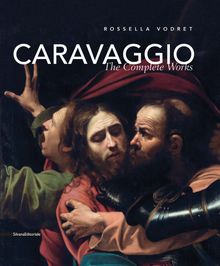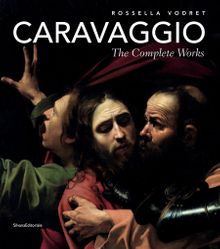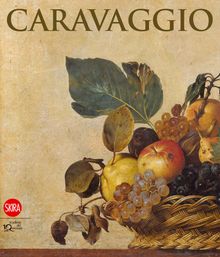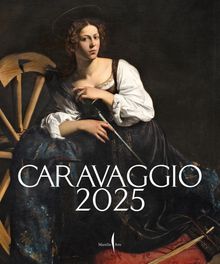| |||||||||||||||||||||||||
ARTIST MONOGRAPHS
|
|
STATUS: Out of stock Temporarily out of stock pending additional inventory. |
 Caravaggio: The Complete Works
Caravaggio: The Complete Works
Published by Silvana Editoriale.
Edited with text by Rosella Vodret.
Dramatic shifts from foreboding dark to probing light, with minimal gradation in between; a realism that exposes all the flaws and folds of human flesh, eschewing Michelangelo’s idealized bodies; a surgical explication of almost unbearably tense emotion; and the poised depiction of crucial moments at the very lip of their unfolding: these were among the innovations of Michelangelo Merisi, known as Caravaggio. Without them, as the great Italian art writer Roberto Longhi once noted, “Ribera, Vermeer, La Tour and Rembrandt could never have existed ... and the art of Delacroix, Courbet and Manet would have been utterly different.” It was Longhi who rescued Caravaggio’s painting for the 20th century, prior to which it had lain dormant since the painter’s mysterious death in 1610. During Caravaggio’s lifetime, however, his work was enormously influential and controversial. Each of his innovations in some way upset the prevailing tendencies of the day—not least when his insistence on physical realism led him to paint Saint Matthew as a bald peasant with dirty legs (attended upon by an irreverently intimate boy angel). Nonetheless, Caravaggio was never short of commissions or patrons, and left to posterity around 80 masterpieces. This monograph documents his complete paintings in high-quality reproductions. Authored by renowned scholar Rossella Vodret, it is the must-have monograph on the artist.
Michelangelo Merisi, known as Caravaggio, was born in 1571 and made his debut in 1600 with two public commissions on the theme of Saint Matthew. He soon became notorious for his temper, and killed a young man in 1606; two further contretemps in Malta and Naples are recorded—the latter, in 1609, involving an attempt on his life—and by 1610 he was dead, after a brief but extraordinary career.
PUBLISHER
Silvana Editoriale
BOOK FORMAT
Hardcover, 9.75 x 11.25 in. / 216 pgs / 150 color.
PUBLISHING STATUS
Pub Date 2/27/2018
Out of stock indefinitely
DISTRIBUTION
D.A.P. Exclusive
Catalog: SPRING 2018 p. 59
PRODUCT DETAILS
ISBN 9788836637133 TRADE
List Price: $60.00 CAD $79.00
AVAILABILITY
Not available
STATUS: Out of stock indefinitely. |
 Caravaggio: The Complete Works
Caravaggio: The Complete Works
Published by Silvana Editoriale.
Edited and text by Rossella Vodret.
PUBLISHER
BOOK FORMAT
Paperback, 9.75 x 11.25 in. / 216 pgs / 150 color.
PUBLISHING STATUS
Pub Date 3/31/2012
Out of stock indefinitely
DISTRIBUTION
D.A.P. Exclusive
Catalog: SPRING 2012 p. 113
PRODUCT DETAILS
ISBN 9788836622351 TRADE
List Price: $49.95 CAD $67.50
AVAILABILITY
Not available
STATUS: Out of stock indefinitely. |
 Caravaggio: The Complete Works
Caravaggio: The Complete Works
Published by Silvana Editoriale.
Edited and text by Rossella Vodret.
Michelangelo Merisi, known as Caravaggio, was born in 1571 and made his debut in 1600 with two public commissions on the theme of Saint Matthew. He soon became notorious for his temper, and killed a young man in 1606; two further contretemps in Malta and Naples are recorded--the latter, in 1609, involving an attempt on his life--and by 1610 he was dead, after a brief but extraordinary career.
PUBLISHER
BOOK FORMAT
Hardcover, 9.75 x 11.25 in. / 216 pgs / 150 color.
PUBLISHING STATUS
Pub Date 10/31/2010
Out of print
DISTRIBUTION
D.A.P. Exclusive
Catalog: FALL 2010 p. 176
PRODUCT DETAILS
ISBN 9788836616626 TRADE
List Price: $60.00 CAD $70.00
AVAILABILITY
Not available
STATUS: Out of print | 11/30/2012 For assistance locating a copy, please see our list of recommended out of print specialists |
 Caravaggio
Caravaggio
Published by Skira.
Edited by Claudio Strinati.
Four hundred years after the death of Caravaggio, some of the world’s most illustrious art historians comment on an extraordinary collection of twenty-five of his works. How is it possible that an artist who lived over four centuries ago is still seen today as an icon of modernity? The answer must be sought in his works; this is where we will grasp Caravaggio’s aesthetic pursuit. He observed without prejudice, hewing close to the truth of things. In short, his was a revolutionary art, one which continues to fascinate laypeople and experts alike to this day. The editors asked some of the world’s preeminent Caravaggio scholars to share their feelings and insights about their favorite works by the artist. The result is an original catalogue of great rigor expressed in deeply human and richly subjective tones. With works from all over the world including Saint John the Baptist from the Nelson-Atkins Museum of Art, Kansas City; and The Musicians from New York’s Metropolitan Museum of Art.
Rossella Vodret is the Director of the Polo Museale in Rome. Francesco Buranelli is secretary of the Pontifical Commision for Cultural Heritage.
PUBLISHER
Skira
BOOK FORMAT
Hardcover, 9.75 x 11.25 in. / 247 pgs / 74 illustrations.
PUBLISHING STATUS
Pub Date 9/21/2010
Active
DISTRIBUTION
D.A.P. Exclusive
Catalog: Publisher Backlist
PRODUCT DETAILS
ISBN 9788857204581 TRADE
List Price: $70.00 CAD $90.00
AVAILABILITY
In stock
in stock $70.00 Free Shipping UPS GROUND IN THE CONTINENTAL U.S. |
